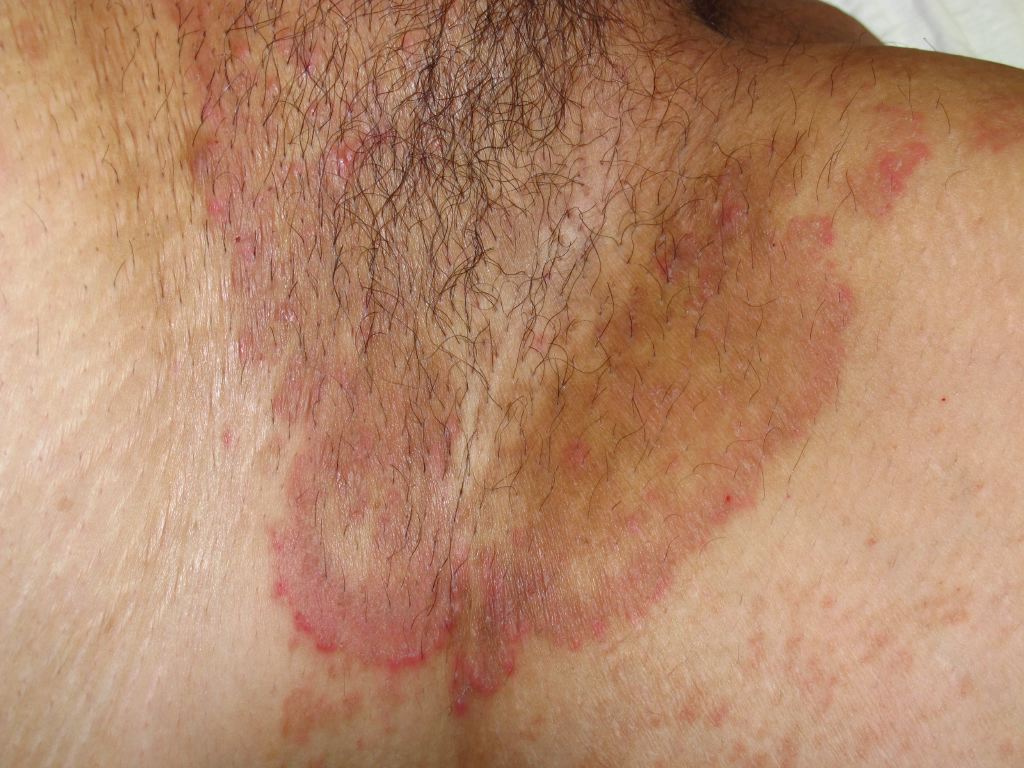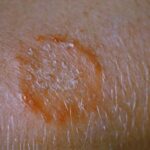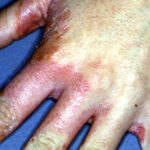Tinea cruris, commonly known as jock itch, is a superficial fungal infection affecting the groin, inner thighs, and buttocks. Caused by dermatophyte fungi, this infection thrives in warm, moist environments and is particularly prevalent among men, athletes, and individuals living in tropical climates. It is highly contagious and can significantly impact quality of life if left untreated.

Causes and Transmission of Tinea Cruris
Tinea cruris results from infection by dermatophytes, primarily fungi from the genera Trichophyton, Epidermophyton, and Microsporum. The most common causative agents include:
- Trichophyton rubrum
- Epidermophyton floccosum
- Trichophyton mentagrophytes
These fungi invade the keratinized layers of the skin and proliferate under conditions of heat, moisture, and friction.
Modes of Transmission:
- Direct contact with infected individuals
- Contaminated clothing, towels, or gym equipment
- Autoinoculation from existing tinea pedis (athlete’s foot) or onychomycosis
- Shared locker rooms or athletic facilities
Risk Factors for Developing Tinea Cruris
Numerous factors predispose individuals to tinea cruris:
- Obesity: Skin folds trap moisture
- Hyperhidrosis: Excessive sweating supports fungal growth
- Tight clothing: Increases friction and humidity
- Poor hygiene
- Immunocompromised state (e.g., HIV, diabetes)
- Participation in sports or communal bathing
Men are more commonly affected due to increased sweating and anatomical structure that favors fungal colonization in the groin.
Clinical Presentation and Symptoms of Tinea Cruris
Tinea cruris typically presents as a symmetrical, red, itchy rash confined to the groin and upper inner thighs, sparing the scrotum. Lesions may appear as annular plaques with raised, scaly borders.
Key Symptoms:
- Intense itching and burning in the groin region
- Red to brown plaques with active scaling borders
- Central clearing in larger patches
- Vesicles or pustules at the periphery in inflammatory cases
- Dry, cracked, or peeling skin in chronic conditions
Differential Diagnosis: Conditions Similar to Tinea Cruris
Accurate diagnosis is vital, as several dermatoses mimic tinea cruris:
- Intertrigo: Inflammatory skin fold condition without active scaling edge
- Candidiasis: Usually involves the scrotum; moist, red plaques with satellite lesions
- Inverse psoriasis: Well-demarcated, shiny red plaques
- Erythrasma: Caused by Corynebacterium minutissimum, fluoresces coral red under Wood’s lamp
- Seborrheic dermatitis: Affects other areas like face and chest
Diagnostic Methods for Confirming Tinea Cruris
Clinical diagnosis is often sufficient, but confirmation is recommended, especially in atypical cases or recurrent infections.
Diagnostic Tests:
- KOH (potassium hydroxide) examination: Reveals segmented hyphae
- Fungal culture: Confirms species, especially in resistant or widespread cases
- Wood’s lamp examination: May assist in ruling out erythrasma
- Biopsy with PAS stain: Used rarely for histopathologic confirmation
Effective Treatment Options for Tinea Cruris
Treatment depends on the severity and extent of the infection. Early intervention with topical antifungals is typically effective. Persistent or widespread infections may require systemic therapy.
Topical Antifungal Medications:
- Terbinafine 1% cream (once or twice daily for 2–4 weeks)
- Clotrimazole 1% cream
- Miconazole
- Econazole
- Ketoconazole
Apply beyond the visible margin and continue use for at least one week after resolution.
Oral Antifungal Therapy (for refractory cases):
- Terbinafine 250 mg once daily for 2–4 weeks
- Fluconazole 150 mg once weekly for 2–4 weeks
- Itraconazole 100 mg twice daily for 1–2 weeks
- Griseofulvin (less commonly used today)
Additional Care Measures:
- Keep the groin dry and ventilated
- Use antifungal powder to reduce moisture
- Change underwear daily
- Avoid tight-fitting clothes during treatment
- Treat tinea pedis simultaneously to prevent reinfection
Prevention Strategies for Tinea Cruris
Adopting preventive habits significantly reduces the risk of recurrence and transmission.
Personal Hygiene:
- Dry the groin area thoroughly after bathing
- Wear breathable, loose-fitting underwear
- Avoid sharing towels or undergarments
- Use antifungal powder if prone to sweating
Environmental Measures:
- Disinfect gym equipment and locker room surfaces
- Wash clothes and linens in hot water
- Ensure athletic gear is cleaned regularly
- Educate sports teams and gym users about fungal infections
Prognosis and Complications
With proper treatment, tinea cruris generally resolves within a few weeks. However, reinfection and chronicity are common if predisposing factors are not addressed.
Possible Complications:
- Tinea incognito: Misuse of corticosteroids alters appearance and worsens infection
- Secondary bacterial infections
- Spread to adjacent areas (e.g., tinea corporis or cruris et corporis)
- Psychosocial discomfort due to chronic itching or discoloration
Tinea Cruris at a Glance
- Tinea cruris is a dermatophyte infection affecting the groin, inner thighs, and buttocks.
- Presents with itchy, red, scaly lesions that may expand with central clearing.
- Diagnosis is confirmed via KOH prep or fungal culture.
- Topical antifungals are first-line therapy; systemic agents for severe cases.
- Maintaining hygiene and dryness in the groin region is essential for prevention.
Frequently Asked Questions:
What is the fastest way to cure tinea cruris?
Topical antifungal creams like terbinafine or clotrimazole, applied twice daily, often provide relief within days and cure in 2–4 weeks.
Can tinea cruris spread through clothing?
Yes, the fungus can survive on clothing and towels. Always wash infected items in hot water and avoid sharing personal belongings.
Is tinea cruris a sexually transmitted infection?
No, but close physical contact can transmit it. It is not classified as an STI.
Can women get tinea cruris?
Yes, though less common than in men, women can develop tinea cruris, particularly those with obesity or excessive sweating.
How can recurrence of tinea cruris be prevented?
Maintain dry skin, treat coexisting fungal infections (like athlete’s foot), and practice good hygiene. Avoid using topical steroids unless prescribed with antifungals.

